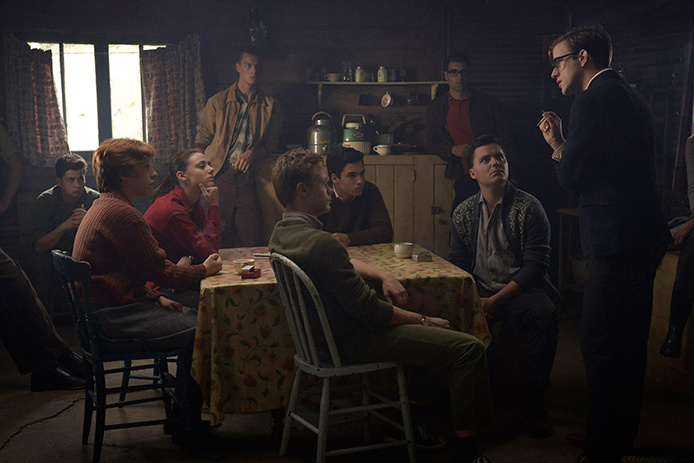In 1991, to launch the first edition of the festival he had just founded, the Festival du cinéma québécois de Blois, the French historian and critic Sylvain Garel chose to present Le party, by Pierre Falardeau. In addition to the fiery filmmaker, Garel, who teaches Quebec cinema at Paris-Diderot University, invites the film’s co-writer, ex-felquist Francis Simard.
Loved by politics, he became passionate about the approach of Falardeau and Simard, with whom he became friends. At the end of the 1990s, he came up with the idea of enrolling at the Sorbonne to do a doctorate on the Quebec Liberation Front (FLQ) in Quebec cinema. However, Sylvain Garel had to put the project on ice since he joined Paris town hall, where he worked for 13 years.
Then came the pandemic… In the absence of a doctoral thesis, he wrote Le FLQ dans la cinématographie québécoise, an essay followed by an index of 250 films and film projects entirely or partially devoted to the FLQ.
“At the start, I wanted to make a “general public” book and a work useful to other researchers, I wanted it to be accessible and factual,” explains the author, met at the Cinémathèque québécoise for the launch of his book and of the cycle The FLQ in Quebec cinematography.
In addition to Louis Fournier and Félix Rose, who respectively signed the preface and afterword of the book, Garel was able to count on the collaboration of the critic Michel Coulombe and the programmer Michel Martin to list the fictions and documentaries that have been filmed since 1963, the year release of À tout prize, by Claude Jutra, the first film in the corpus.
“Knowing Quebec cinema relatively well, I must say that what surprised me is that there is no fiction on the Battle of the Plains of Abraham nor on the internment of Italians during the Second World War. World War. There is very little about the Patriots and the rebels. Lots of very important historical events are kept out of cinema for financial reasons. However, I found 207 completed films, 49 of which are devoted mainly or entirely to the FLQ, which is considerable compared to the cinematography of a country of 8 million inhabitants. »
According to Sylvain Garel, if we find so many films about the Quebec Liberation Front, it is because Quebec cinema and the Felquist movement were both born in the midst of the Quiet Revolution. “In the 1960s, young filmmakers and felquists were the same age. Almost all filmmakers have common aspirations with the FLQ; many are independentists and several will become socialists. Even if they do not share the means of action of the FLQ, these filmmakers have sympathy for these young people who follow through with their ideas, who risk their future, their lives. »
Although there were 10 deaths, including Minister Pierre Laporte, Sylvain Garel recalls that there is still sympathy for the FLQ today: “The FLQ has never carried out indiscriminate attacks. If we compare with ETA, it’s 800 dead, and the IRA, 1800 dead; we are completely in another dimension. »
The low presence of women in the FLQ – 20 women out of the 250 felquistes listed by Louis Fournier – and behind the camera at the time still explains today why few women have exploited the subject on screen: “Le Front de Women’s Liberation did not support the FLQ manifesto because it did not have a word on women. And it’s 11 minutes long! »
Who knows, in the coming years, female directors will perhaps take an interest in forgotten emblematic figures, including Hélène Bourgault (1945-2006), founder of the FLF and the only Felquist to become a filmmaker.
“Since I finished writing in May, five new films have been made, including Testament, by Denys Arcand, where a couple recalls the events of October 1970, and that of Pedro Ruiz on Jacques Lanctôt which comes out on Friday, The eighth floor, days of revolt, which combines fiction and documentary”, concludes Sylvain Garel, who, at the end of the book, invites readers to inform him of errors and omissions for a possible reissue.
From October 25 to 31, the Cinémathèque québécoise presents Le FLQ dans la cinématographie québécoise, a cycle bringing together around ten short and feature films selected by Sylvain Garel and Guillaume Lafleur. “There are classics, like October, by Pierre Falardeau, Corbo, by Mathieu Denis, Les Rose, by Félix Rose, and, the one which remains the reference, The events of October 1970, by Robin Spry, several images of which have been used in other films. There are also rare films, including the first film on the FLQ, FLQ, a 1967 documentary by Jean-Pierre Masse, which gives voice to four felquists leaving prison. And forgotten films, such as The Dream Years, by Jean-Claude Labrecque, which was rather poorly received in 1984, in the midst of the post-referendum depression. The first evening, we present two films: Labrador Chronicles, André Forcier’s first film, a completely crazy schoolboy thing, but very revealing of the mentality of young people of the time; and The Revolutionary, a much more ambitious film by Jean-Pierre Lefebvre from 1967. I think that through these ten films, we will better know the history of the FLQ. »















